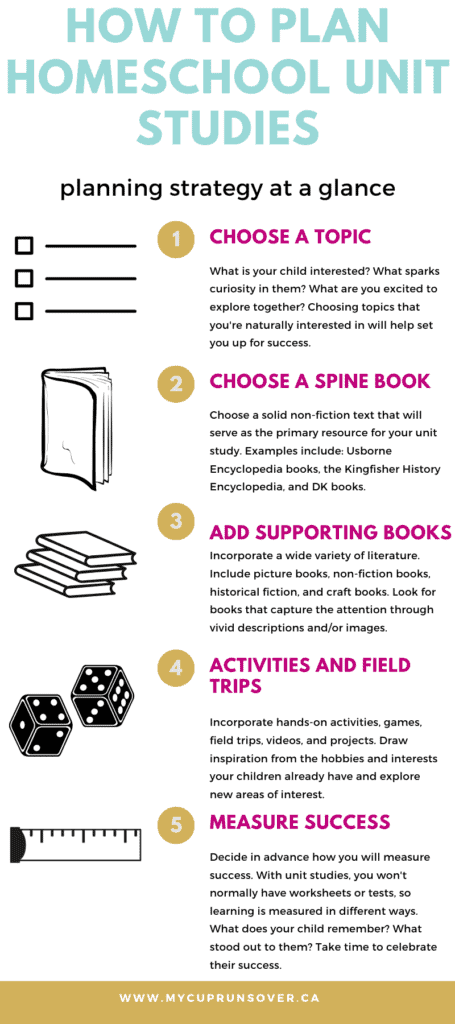Need a break from curriculum? Why not try some unit studies? We’ve complied over 170 unit study ideas to inspire the next adventure in your homeschool or classroom.

Unit Study Ideas for Your Homeschool or Classroom
Unit studies are a great alternative or complement to curriculum in your homeschool. They give you an opportunity to pursue an interest or curiosity to wherever it takes you, and this is where some of the best learning happens.
You can make the unit study as wholistic or focused as you want, though I recommend not trying to force subjects into the framework of a unit study just to check off a box. Learning will happen best if the unit study feels like a natural foray into a new topic rather than an effort of the homeschool mom to cover every school subject through the lens of a butterfly, say.
To help you get started, we’ve compiled a list of over 170 unit study themes. (We tried to keep the list to 100, but there are just too many amazing topics to learn about!)
Where possible, we’ve provided links to some unit study resources from a number of sites: our own, those of our homeschool blogger friends, and a few from unit study curriculum providers.
We hope this list will spark your imagination and help you plan your next unit study.
How to Plan a Unit Study
Planning a unit study is simple, but putting in a little work up front will help things run even more smoothly. We all know what it’s like to be scouring the library the night before we’re supposed to read a book, only to find out that it’s got a long hold list, or searching Pinterest at midnight for a science experiment that only uses baking soda and water. (It’s not just me, is it?)
If you like, you can use a unit study planner to organize your unit study resources. I like this free one from Teachers Pay Teachers.
Next, select a spine book. This book will be your main go-to when you start working through your unit study. Within it, you’ll be able to find topics or rabbit holes to meander down.
Here are some examples of spine books:
Now it’s time to hit up that library website and find the best books available on your subject. We like to take advantage of multiple sources, including our local library and those in surrounding cities, the library of the school we register through, and digital libraries such as Sora, Overdrive, Hoopla, and Kindle.
If you don’t have it already, I highly recommend the Library Extension for Chrome. Simply install it in the Chrome browser and connect all the libraries to which you have a membership. Then when you’re looking at books on sites like Amazon, it will automatically tell you which of your local libraries has copies of that book. It’s genius!
Then comes the really fun part: field trips and activities. For me, these are the best parts of homeschooling. We love doing crafts and hands-on activities that help us deepen our understanding of what we’re learning, and even more than that, we love getting out of the house and actually going to visit places that give us an immersive experience.

For more help, see: how to create your own unit study.
Finding Done-for-You Unit Study Resources
As fun as it can be to seek out and compile your own unit study resources, sometimes you just don’t have the time. You need a quick, done-for-you solution.
Thankfully, as the unit study approach grows in popularity and the field of content creators expands, it’s becoming increasingly easy to find pre-made unit study packages for nearly any topic. You can even find many free unit studies on the Internet.
UnitStudy.com
One great resource is UnitStudy.com (Amanda Bennett Unit Studies). Here you will find hundreds of affordable unit studies covering a range of topics from science, history, geography, and the creative arts.
I have linked to many of their unit studies throughout this post, but you can view the whole catalog here.
Our Journey Westward
Homeschool moms Cindy West and Melissa Leach offer several nature-themed unit studies in their series, NaturExplorers.
Each unit study includes:
- inspiration for the parent or teacher and inspirational literature suggestions for children,
- background information concerning the main focus of the topic,
- ideas for nature walks and other outside activities,
- hands-on activities,
- writing and research ideas,
- references for Bible study, artist and composer study, and poetry tie-ins,
- bonus ideas for other subjects,
- book lists,
- ideas for adapting material for other age groups, and
- notebooking pages.
While the unit studies are useful for any type of learner, those who enjoy Charlotte Mason homeschool curriculum will especially enjoy these studies. Our family enjoyed 100+ Easy and Fun Creative Nature Walks for All Ages.
I’ve linked to several of the NaturExplorers unit studies below, but you can also view the whole series here.
Five In a Row
Five In a Row are easy-to-follow, highly effective instructional guides for teaching social studies, language, art, applied math and science using outstanding children’s literature as the basis for each weekly unit study. Lessons are designed for children ages 5 through 9, and include a discussion guide and questions, teacher answers, hands-on activities, and suggestions for further study.
They also have additional levels for preK and for upper elementary. Here is Cathy Duffy’s extensive review of Five in a Row.
Around the World with Picture Books
This series of unit studies for children in kindergarten to grade three introduces children to world geography and culture through award-winning picture books. Each continent or country study includes nature study, folk tales, fables, music, art, poetry, and history.
Children get to complete fun activities and respond to what they’re learning through journaling. History, biography, and culinary suggestions are included to help round out the studies.
Beautiful Feet Books, the publisher of the Around the World with Picture Books Series, also offers history-based literature packs for kids up to grade twelve.
Homeschool Unit Study Themes
In this post, we’ve listed over 170 ideas for your next unit study, but this list could easily have included a thousand or more ideas.
As you start listing out all the different topics you could study with your kids, you realize the possibilities are endless. And as you drill down into ever more specific content, the list keeps expanding exponentially.
With this list, I’ve tried to strike a balance between broad and specific topics. There are topics on here that could take you months to give adequate coverage to (human anatomy, the continents, earth, and the Industrial Revolution, for example) and there are others that will probably take a week at most (such as pumpkins, Thanksgiving, or Gandhi).
This list is not meant to be definitive, but rather to spark your imagination. I’ve offered a few ideas of specific animals, people, places, events, etc., that I think are both worth studying and have sufficient resources available to help you build a unit study around.
But don’t stop here: drill down on a topic until you get to one specific aspect of it, or zoom out to get a bigger picture.
If you study one composer, why not expand your theme and study several others? Perhaps not back to back, but you might have a composer of the month, or one for each season (Vivaldi springs to mind there, doesn’t he? But figuring out which season to put him in would be a challenge!)
Further, you don’t need to have only one unit study on the go at a time. You might have several.
For example, you could have a season, an animal, a famous person, a country, and a historical event. If possible, you might link these together so they all share a common thread making for an epic thematic unit, but it’s not necessary to do so.
If your children show very strong interested in specific animals, people, places, or topics, by all means, follow the passion!
With all that said, let’s get to the list!
Animals
Specific Types of Animals
1 Birds (general)/Backyard birds
2 Bees
3 Butterflies
4 Bugs (here’s one on Charles Henry Turner, American zoologist known for his studies of insects; and another on fireflies)
5 Spiders
6 Bats
7 Frogs
8 Farm animals
9 Sea life
10 Sharks (here’s one on Eugenie Clark: “The Shark Lady” and another on a shark’s life cycle.
11 African Animals
12 Dinosaurs (here’s one on Mary Anning: “The Dinosaur Lady”)
13 Reptiles (see: reptile facts for kids)
14 Amphibians
15 Mammals
Animal-Related Topics
16 Adaptation
17 Endangered species
18 Animal habitats
19 Hibernation
20 Food chains
Plants
21 Plants (in general)
22 Trees
23 Flowers
24 Edible plants
25 Pumpkins
26 Apples
27 Leaves
28 Anatomy of plant cells
29 Fungi
Life Science – Other
General Life Science Topics
30 Human anatomy (Here’s a fun song to help you teach the bones of the human body!)
31 Bacteria and viruses
32 The five senses
People
People and the Work They Do
33 Composers/Musicians
34 Artists
35 Inventors (Here’s one on George Ferris, inventor of the Ferris Wheel)
36 Writers
37 Presidents/Prime ministers of your country
38 Community helpers
39 Healthcare workers
40 Archaeologists
41 Scientists
42 Architects
Groups/People Groups of Historical Significance
43 Explorers
44 Pioneers
45 Native American Tribes (Here’s one on Winter Counts–pictorial tribal history calendars)
46 Suffragettes
47 Civil rights leaders
48 Aztecs
49 Mayans
50 Romans
51 Greeks
Specific People
52 Albert Einstein
53 Amelia Earhart
54 Clara Barton
55 Harriet Tubman
56 Helen Keller
57 Leonardo Da Vinci
58 Mahatma Gandhi
59 Marie Curie
60 Martin Luther King Jr
61 Maya Angelou
62 Mother Teresa
63 Mozart
64 Nelson Mandela
65 Pablo Picasso
Geography
Learn how to teach geography without curriculum and then create your own unit study on one of the regions or countries below.
Continents
66 The continents
67 Africa
68 Antarctica
69 Asia
70 Oceania/Australia
71 Europe
72 North America
73 South America
74 The Arctic
Countries
75 Australia
76 Brazil
77 Canada
78 China (and more resources on China)
79 Egypt
80 England
81 France
82 Germany
83 India
84 Indonesia
85 Japan
86 Mexico
87 Nigeria
88 Pakistan
89 Russia
90 Spain
91 United States
Earth Science
Landforms, Biomes, and Bodies of Water
92 Seas and Oceans
93 Ponds, Lakes, and Rivers
94 Coasts and Beaches
95 Mountains
96 Forests (here’s one on rainforests)
97 Deserts
98 Volcanoes
99 Glaciers
100 Volcanoes
101 Rocks and Minerals
Space Science
Space-Related Topics
102 Earth
103 Outer space/ solar system (more outer space resources)
104 The moon
105 The sun
Meteorology and Weather
106 Seasons (general)
107 Winter (see also: Winter Nature Study ideas)
108 Spring (and another)
109 Summer
110 Fall
111 Ecosystems
112 Weather (in general) – (more weather resources)
113 Hurricanes
114 Earthquakes
115 Hurricanes
116 The water cycle
117 Snow (further exploration of winter precipitation)
118 Clouds
Other Sciences
Physics
119 Force and motion
120 Simple machines
121 States of matter (here’s one on the Science of Non-Newtonian Fluids)
122 Light
Chemistry
123 Periodic table
124 Chemical reactions
125 Crystals
Technology
Transportation
126 Types of Transportation
127 Transportation Infrastructure
128 Trains
129 Aircraft
Computer Technology
130 The Internet
131 Computers
132 History/Evolution of Phones
133 Energy production and harvesting
134 Photography
135 Artificial intelligence + robots
Time Periods and Significant Historical Events
136 Ancient Egypt
137 Ancient China
138 Indus-Valley Civilization
139 Mesopotamia
140 Middle Ages/Medieval Period
141 Viking Age
142 The Renaissance
143 Age of Discovery
144 Elizabethan Period
145 Industrial Revolution
146 World War 1
147 The Great Depression
148 World War 2
149 The American Civil War
150 The Gold Rush
151 The Fur Trade
Holidays and Events
152 Thanksgiving (and Thanksgiving history)
153 Christmas (and Advent)
154 Halloween
155 Easter
156 Elections
Activities
157 Gardening
158 Baking
159 Scrapbooking
160 Finances (Budgeting, Investment)
161 Recycling
162 Sports (here’s one on soccer)
Literature
163 Roald Dahl books
164 CS Lewis books
165 Little house on the Prairie
166 Charlotte’s Web
167 Harry Potter
168 Tolkien books (The Hobbit or Lord of the Rings)
169 Shakespeare (one fun way to teach homeschool Shakespeare—memorize some epic monologues).
170 Poetry
171 The Wind in the Willows
172 Anne of Green Gables
I hope this collection of unit study ideas has thoroughly inspired you to try a new unit study in your homeschool or classroom. I’m sure the next challenge will be narrowing down the list!
Leave a comment below and let me know which unit study ideas you’re most excited to try with your learners and don’t forget to save this post to Facebook or Pinterest so you can find it later.

Sophie Agbonkhese is a writer, homeschooling mother of four, and a recovering overachiever (who occasionally relapses). She is the founder of My Cup Runs Over, a site dedicated to helping busy women simplify and enrich their lives. When she’s not writing or debugging websites, Sophie spends her time reading, dancing, bullet journaling, reading, gardening, listening to audiobooks, and striving fruitlessly to have a clean house for at least five minutes.



Thara
Monday 7th of November 2022
I love doing unit studies. We have finished up a two week one recently on pumpkins and Halloween. We went to a local pick your own farm in order to pick some and calculated the costs of buying pumpkins. I next handed out a short but interesting quiz on pumpkins then we sketched them as well. The kids also had to draw me a colourful map of the world. After that I got them to make me pumpkin soup and fresh croutons for Halloween lunch. Finally they went to research Halloween art online. We even practiced our selling technique. For maths we discussed the range of costs and weights of types of pumpkins. And we calculated the different pumpkin sizes and shapes too. We carved them up. We examined a whole pumpkin and used it as a stimulus for poetry. It was a lot of fun. In weekly gardening and cookery lessons we learnt about why pumpkins are so important to our society on the whole. And I sat down and talked about how pumpkins are literally grown from nothing and cared for carefully over time in a hour long oral world history lesson. We read a couple of stories about pumpkins.
SOPHIE AGBONKHESE
Wednesday 16th of November 2022
Sounds like there is so much awesome learning going on in your homeschool!